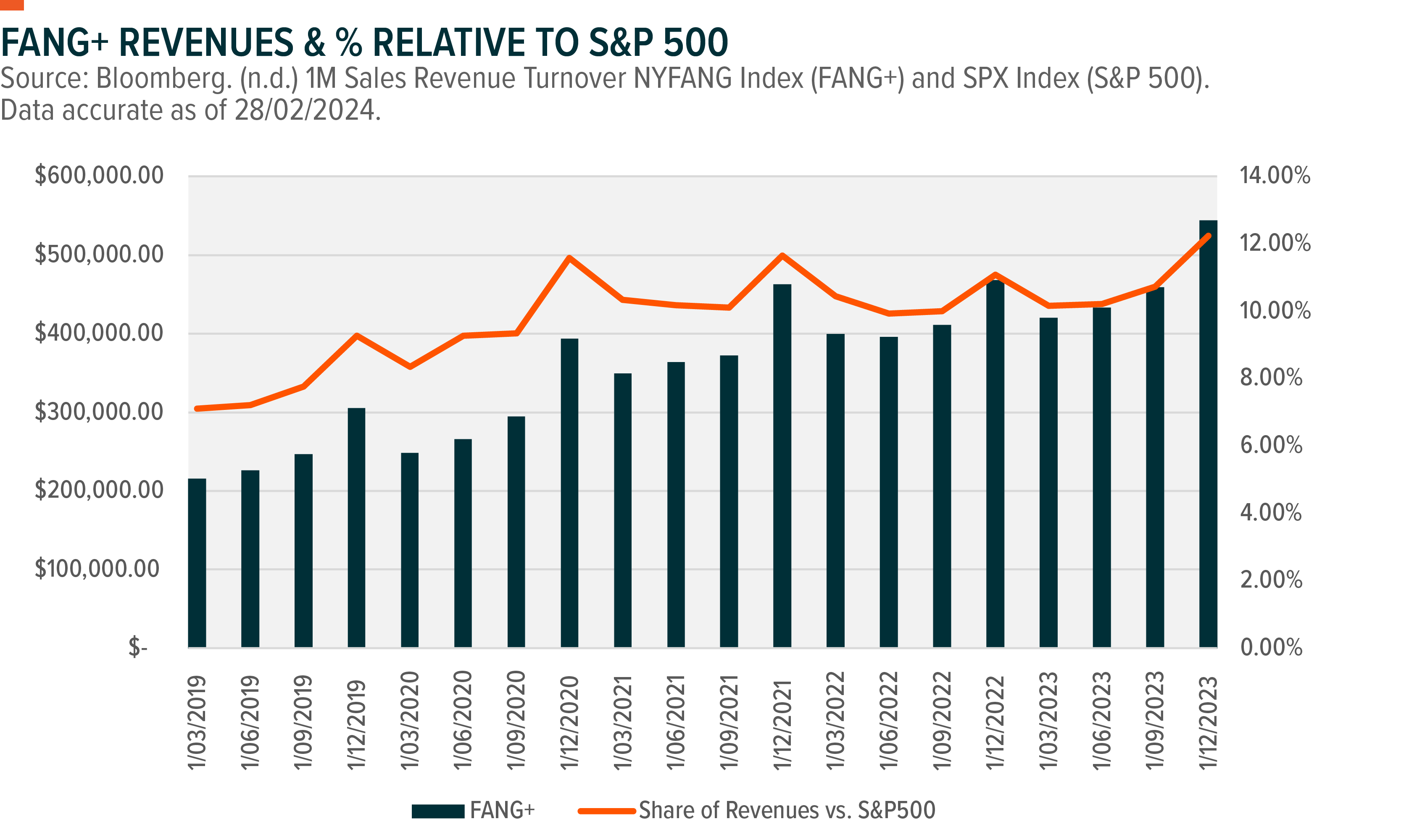Monopolies have changed: Why the FANG+ are built different
The spectre of dominant corporations losing their momentum hangs heavy, conjuring images of fallen giants like Exxon and General Motors in the 1980s and 1990s. However, to equate these historical examples with the FANG+ companies of today’s tech landscape is to miss a crucial distinction.
Unlike the resource-based monopolies of the past, these companies thrive on innovation, agility, and dynamic ecosystems, constantly evolving and adapting to the ever-shifting technological landscape. Different than Exxon and GM, whose power stemmed from control over physical resources, the largest companies in the world today wield intangible assets like data, intellectual property, and network effects. These assets are inherently more adaptable and less prone to obsolescence.
Furthermore, the regulatory landscape surrounding these companies is vastly different from that faced by monopolies of the past. Antitrust concerns, while present, are often overshadowed by the immense societal benefits these companies provide. Free communication tools, ubiquitous access to information, and constant technological advancements create a complex calculus for regulators, potentially mitigating the risk of forced breakups.
Their recent strong performance, fuelled by solid earnings and their ubiquitous role in key technological platforms such as cloud computing and digital media, alongside the growing impact of artificial intelligence (AI), may underscore the sector’s durability and expanding role in the economy.(1)
Looking ahead to 2024, there is optimism reinforced by the sector’s agile and dynamic dominance of paradigm-shifting technologies, strategic stock buybacks, and growing dividend distributions.
FANG+ Companies Have Grown Their Revenue at Faster Pace Than Rest of the Market

Of note, SNOW is not part of the S&P500 constituents, but it’s included in the FANG+ calculation.
Critical pillars of innovation
The FANG+ companies have transcended mere market share to become engines of innovation, shaping entire industries and driving technological advancement. But there are several verticals that set them apart.
Digital Media
From social media platforms to streaming services, these companies dominate the digital media landscape.
Within the digital advertising landscape, Alphabet (NASDAQ: GOOGL) and Meta (NASDAQ: META) dominate, leveraging the extensive reach of Google, YouTube, Facebook, and Instagram for targeted advertising. Microsoft (NASDAQ: MSFT) and Amazon (NASDAQ: AMZN) are also carving out significant niches; Microsoft is advancing search advertising with Bing, and Amazon is capitalising on its e-commerce dominance to offer advertisers prime real estate, solidifying its position in the market.
For example, according to fourth quarter figures, Meta’s revenue surged 24% year-over-year (YoY) to US$38.7 billion, demonstrating continued momentum in this crucial sector. Amazon’s advertising arm echoed this trend, expanding by 27% YoY to reach US$14.7 billion. Alphabet, too, saw sustained growth, with Google and YouTube advertising revenues rising by 11% and 16% YoY, respectively, solidifying their dominance in the digital advertising landscape.(2,3,4)
This growth, fuelled by an improving economic climate and advancements in AI, signals a positive future for the digital advertising sector. It is anticipated that global advertising expenditures will rise by 10% in 2024, with digital advertising accounting for 70% of this increase.(5)
Amazon’s competitive advertising platform extends from its e-commerce leadership. The company is projected to grow its U.S. retail e-commerce sales by 11.5% to US$492.23 billion in 2024, thanks to its pioneering third-party marketplace strategy and Amazon Prime’s success.(6)
Parallel to this, subscription services are increasingly vital as a recurring source of revenue. Apple and Netflix exemplify the potential and resilience of subscription-based revenue models. Apple’s services segment, inclusive of Apple Music, Apple TV+, and iCloud, reported record revenue of US$23.12 billion in Q4.(7) The company’s strategic pricing adjustments, including the increase of Apple TV+’s monthly subscription fee to US$9.99 in the U.S., highlight the strength of streaming giants’ pricing power.(8) This is further evidenced by Netflix, which experienced a 70% quarter-on-quarter (QoQ) growth in Q4, following the introduction of an advertising-supported subscription tier and enforcing password-sharing policies.(9)
Cloud computing
Gone are the days of siloed infrastructure. The FANG+ companies have championed cloud computing, offering unparalleled scalability, security, and cost-efficiency.
The competitive landscape of cloud computing in the final quarter of 2023 saw giants like Microsoft, Amazon, and Alphabet commanding a substantial 67% of the US$74 billion global cloud infrastructure market.(10) Their flagship offerings—Azure, Amazon Web Services (AWS), and Google Cloud—benefited from the integration of AI, which played a pivotal role in propelling cloud infrastructure revenues to new heights. In fact, an 8.2% QoQ increase, amounting to a US$5.6 billion rise, marked the highest sequential infrastructure revenue growth in the cloud market’s history.(11)
Microsoft’s Intelligent Cloud segment, which includes Azure, SQL Server, and Windows Server, among others, reported a 19% YoY revenue increase to US$25.9 billion.(12) Azure stood out with a 30% growth in its IaaS business, powered by what has been termed an “AI advantage.”(13) This growth, supported by 53,000 Azure AI customers, a third of whom joined in the past year, underlines Microsoft’s strategic AI investments.(14) This includes an integral partnership with OpenAI, enhancing its competitive edge over AWS and Google Cloud. AI services alone contributed nearly 6 percentage points to Azure’s annual growth, indicating broad adoption across its offerings.(15)
Amazon’s AWS has continued to be a major profit driver, witnessing a 12% YoY sales increase to US$24.2 billion.(16) The launch of GenAI tools like Bedrock and the Amazon Q coding assistant indicate AWS’s commitment to innovation, enabling it to maintain revenue growth throughout 2023 and effectively compete in the expanding AI market.
Alphabet’s Google Cloud has marked a significant milestone, turning profitable in 2023 and doubling its revenue over two years, driven by a surge in new customer acquisitions.(17) Its performance was particularly highlighted by a 25% YoY revenue increase in the fourth quarter of 2023.(18) Key to its success has been the strategic licensing of Gemini technology for enhanced application integration, alongside the widespread adoption of its AI Hyper-computer and Vertex AI platform, which saw Vertex AI API requests increase sixfold.(19) These advancements have not only solidified Google Cloud’s technological leadership but also significantly bolstered its position in the competitive cloud computing market.
Amidst these developments, Snowflake has emerged as a key player in data analytics and management software, leveraging the infrastructures of AWS, Azure, and Google Cloud. Transitioning into a comprehensive cloud data management platform, Snowflake’s role within the digital commerce and cloud technology ecosystem is becoming increasingly prominent.(20)
Artificial Intelligence
AI’s journey from experimental stages to widespread commercialisation and monetisation is reshaping how the largest companies in the world operate, allowing them to establish AI services businesses and enhance revenue and profit growth across key verticals.
Tesla’s (NASDAQ: TSLA) pioneering efforts in electric vehicles and energy solutions epitomise the transformative potential of AI. The company’s advancements in autonomous driving serve as prime examples of AI’s move towards broad commercialisation, significantly influencing industry innovation. This AI-driven strategy propelled Tesla to achieve record global sales of 484,507 vehicles in the fourth quarter of 2023, marking an impressive 20% increase from the previous year.(21)
Other major tech companies are already seeing value in AI integration. Amazon has leveraged AI to optimise its shopping and logistics operations, resulting in exceptional profit margins. Alphabet has utilised AI to refine ad targeting and performance, simultaneously building a foundation for AI-as-a-service through Google Cloud. Microsoft’s Intelligent Cloud vertical has seen growth spurred by increasing demand for AI services, while Meta has harnessed AI to improve ad efficiency and cost-effectiveness, generating substantial cash flow that led to the announcement of its first dividend.(22)
The consensus among these tech giants is unmistakable: AI investment is crucial for sustained product innovation and financial health.
To support this ongoing growth, significant capital expenditures are being funnelled into data centres, expected to unlock new revenue streams for chipmakers like Nvidia (NASDAQ: NVDA). Despite facing challenges such as Nvidia chip shortages, which have prompted cloud service providers to seek alternatives, Nvidia’s pre-eminence in AI training remains unassailable. The company’s meteoric rise in market value over the past year has solidified its position as the leading producer of AI application chips, a status further cemented by its recent milestone of surpassing Amazon in market capitalisation.(23)
Similarly, AI infrastructure leader Broadcom’s development of application-specific integrated circuits (ASIC chips) significantly boosts the speed and reliability of AI models. With AI-related sales expected to constitute a quarter of its total sales in 2024, up from 15% the previous year, and profit margins around 60%, Broadcom is set to play a crucial role in advancing AI technologies.(24)
Conclusion: Persistent growth trajectories
The dominance of the FANG+ stocks within verticals such as digital media, cloud computing, and artificial intelligence stresses a significant phase of technological evolution and market leadership.
In digital media, these companies have revolutionised advertising and content delivery, leveraging AI to enhance user engagement and monetisation strategies. In cloud computing, their infrastructure and platforms serve as the backbone for a myriad of services, driving innovation and efficiency across industries. The integration of AI across their operations and offerings further cements their status as pioneers, pushing the boundaries of machine learning and AI applications to create new value and opportunities.
The financial position of these companies is further underscoring the opportunity ahead. Consensus estimates project a staggering US$190 billion in collective stock buybacks for 2024, with Apple alone aiming for US$100 billion annually by 2027. This, coupled with their market leadership and innovation focus, suggests a new paradigm of corporate power built on strategic positioning, not temporary measures.

1 topic
7 stocks mentioned
1 fund mentioned

